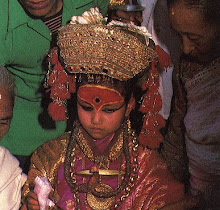 Dashain is one of the major festivals celebrated in Nepal. The festival, which falls around the month September-October, is also celebrated all around the world by the Nepalese Diaspora. Since family and relatives gather while worshipping gods and goddess and celebrating the days, the value of the festival has also increased. Family dispersed in due of their works returns to their home during Dashain.
Dashain is one of the major festivals celebrated in Nepal. The festival, which falls around the month September-October, is also celebrated all around the world by the Nepalese Diaspora. Since family and relatives gather while worshipping gods and goddess and celebrating the days, the value of the festival has also increased. Family dispersed in due of their works returns to their home during Dashain.The festival is a blend of Hindu Tantrik and animistic harvest festival traditions. Ghatasthapana is the first days of the festival. "Dashain Ghar", special worship room is set up on this day, where Astha-Matrikas (the 8 tantrik goddesses) and Nava Durgas (the 9 durga goddesses) are worshipped. Barley is sowed on big earthern pots which have a coating of cow dung. These seeds will sprout in ten days. The sprouts, which symbolize a good harvest, will be decoratively placed on the heads of family members later on in the festival as a blessing.
On the seventh day, Fulpaati, the town of Gorkha sends an offering of flowers to Kathmandu. A band associated with the army also plays its music and goes through the old core of Kathmandu.
Day after Saptami is Asthami - the day of sacrifices. Goddess temples all over the Kathmandu Valley receive sacrifices, ranging from goats and buffaloes to ducks and chickens. Blood, symbolic for its fertility, is offered to the goddesses. This meat is taken home, cooked and takes the food as a blest by divinity. This food, after offering to the household gods, is shared amongst the family.
Sacrifices continue on Navami, the ninth day. Families will visit various temples around the Kathmandu Valley. On the tenth day, "Dashami," a mixture of rice, yogurt and vermillion will be prepared by the women. This preparation is known as "Tika". Elders put this on the forehead of youngers to bless them with fertility and abundance in the upcoming year. The red also symbolizes the blood that ties the family together. Elders will give "dakshina", or a small amount of money, to younger relatives at this time. The Tika continues for five days, during which time people also gather to play cards around massive amounts of food and drink.
In several parts of Nepal, Dashain is the only time of the year when people receive a set of new clothing. Likewise, in poorer families, the animal sacrifice was eagerly anticipated since it might be the only animal protein the family would eat all year. This may be true in certain parts of Nepal where food is in low supply, but is less so in the cities. In general, the tradition of sacrifice is lessening with the easy availability of meat for daily consumption, and with the influences of Vaishnav Hindus (who are vegetarian).

